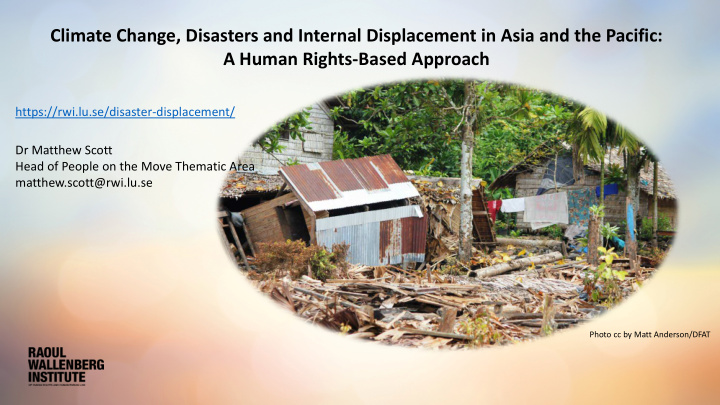



Climate Change, Disasters and Internal Displacement in Asia and the Pacific: A Human Rights-Based Approach https://rwi.lu.se/disaster-displacement/ Dr Matthew Scott Head of People on the Move Thematic Area matthew.scott@rwi.lu.se Photo cc by Matt Anderson/DFAT
Overview • Research impetus, questions and countries • Three outputs • Two key take aways • Next steps
China Research frame, questions, countries Cambodia Thailand Myanmar FRAME: Human Rights in DRM Philippines Indonesia • GP20 Nepal Bangladesh • Sendai Framework for DRR – Paragraph Solomon Islands 19(c) Vanuatu • GPDRR 2019 Co-Chairs’ Summary • FRDP Goals 1 and 3 – eg Priority Actions i(f) QUESTIONS on HRBA and i(p) on displacment For each of the 10 countries: • APMCDRR 2020 agenda 1) To what extent does domestic law and policy reflect key rights-based international standards and guidelines relating to displacement? 2) To what extent is the domestic legal and policy framework reflected in one specific instance of displacement?
Three research outputs – 1 – Background Brief 1. Background brief on international standards and guidelines relating to displacement in the context of disasters and climate change o Consolidates international standards and guidelines in an accessible summary document. o Provides the baseline from which the 24 principles used to analyse the national law and policy frameworks derive
Background Brief 1. Follows GPID structure, with sections on prevention of displacement, during evacuation and throughout displacement and towards durable solutions 2. Incorporates principles from • Guiding Principles on Internal Displacement • Sendai Framework on Disaster Risk Reduction • UNDRR Words into Action Guidelines • Guidance on Protecting People from Disasters and Environmental Change through Planned Relocation • Planning Relocations to Protect People from Disasters and Environmental Change: A Toolbox • Agenda for the Protection of Cross-Border Displaced Persons in the Context of Disasters and Climate Change • IASC Operational Guidelines on the Protection of Persons in Situation of Natural Disasters • IASC Guidelines for Integrating Gender-Based Violence Interventions in Humanitarian Action • The Comprehensive Guide for Planning Mass Evacuations in Natural Disasters • The Sphere Project: Humanitarian Charter and Minimum Standards in Humanitarian Response • IASC Framework on Durable Solutions • Durable Solutions Analysis Guide and the Durable Solutions Indicator Library • UN Principles on Housing and Property Restitution for Refugees and Displaced Persons (the ‘Pinheiro Principles’) • CEDAW, General Recommendation No 37 on Gender-Related Dimensions of Disaster Risk Reduction in the Context of Climate Change 3. Consolidates this material into 24 core principles, which are then used to evaluate national law and policy
Three research outputs – 2 – Law and Policy Reports 2. Law and policy reports • Charts displacement over past ten years • Consolidates Concluding Observations from treaty monitoring bodies relating to climate change, disasters and displacement • Presents the domestic legal and policy framework for the country • Drawing on the 24 principles derived from the Background Brief, evaluates the extent to which domestic law and policy reflects international standards • Makes some concluding observations • Intended to generate discussion in planned consultations / blended learning / serve as a tool for domestic/international actors working with the issue
Observations from Vanuatu and the Solomon Islands 1. NPCCDID 2018 expressly 1. NDMP 2018 expressly rights-based approach, aligned with FRDP 2016-2030 aligned with FRDP 2016-2030 2. Need to develop a national 2. NPCCDID calls for integration strategy on planned of displacement into relocation (now initiated) development planning 3. Focus on IDPs in evacuation 3. Attention to particularly and camp management in vulnerable groups in NDMP 2018 Evacuation Centres policy 4. Self-sufficiency requirement? 4. Self sufficiency requirement? 5. Express incorporation of 5. More on protection beyond GPID and IASC Guidelines in emergency phase of SOPs displacement? 6. No treatment of durable 6. Detailed engagement with solutions durable solutions in NPCCDID
Three research outputs – 3 – Academic volume 3. Academic volume • Examines a specific instance of disaster displacement in the country • Considers the extent to which the legal and policy framework described in the law and policy report contributed to the prevention of displacement, protection during evacuation and throughout displacement and facilitated durable solutions. • You will hear more about this from Tess and Joseph
Key policy take aways from Vanuatu and Solomon Islands research 1. Strong legal and policy frameworks need support for implementation : Both countries have taken considerable steps to develop robust frameworks, grounded in the FRDP 2016-2030 and expressly integrating rights-based principles. How is this working in practice now? What challenges and opportunities? 2. Potential for peer exchange given both countries are working on rights-based approaches, within the context of the FRDP
Next steps Consult widely on priorities of actors in the region and develop programmes in partnership Develop and deliver a blended learning Present key findings at APMCDRR 2020 in course, drawing on local expertise and Australia facilitating peer to peer exchange
Recommend
More recommend